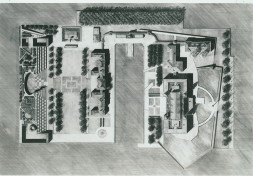DIS- LOCATION
When I was invited to represent the US in the 1980 Venice Biennale I wanted to counteract the superficiality of the main exhibit –a series of post-Modern façades called the Strada Nuovissima –with a project that resonated with larger social and cultural issues. My proposal for Ellis Island in the New York Harbor, long abandoned and closed to the public, was at once biographical and political. It bothered me that there was no place in Ellis Island, point of entry of twelve million immigrants, to commemorate their passage and their material and immaterial contributions to the nation. Also, the monuments and memorials that inscribed relevant events in the city’s collective memory did not remember the lives of common people (unless they were military casualties) as it is customary today. To remember those who left their former lives to start anew in America I would have to consider what it means to be an immigrant. That is why I wanted to embed the experience of displacement in my 1980 proposal for a park that would include a Museum of Immigration, a Center for the Study of American Ancestry, and a great open space that could be used for festivals and parades staged by the different immigrant groups,
When I moved to New York in 1968 I sought the company of people who, like myself, defined their identities as cosmopolitan “citizens of the world”. But I also came into contact with other Latin Americans who considered themselves immigrants. It was unexpectedly upsetting to find that, regardless of social class or level of education, they lived lives marked by the disturbances and injuries of dislocation. Displacement was so embedded in their lives that I wanted visitors to Ellis Island to experience this complex and ambivalent emotional reality. This is the origin of the fractured landscape in the half of the island that contains the Immigration Station. The island itself had been subject to severe physical changes from nothing more than a small, muddy islet to its present, constructed shape. The overlapping of its successive changes in outline resulted in a landscape that echoed in its fragmentation the not quite having left, not quite having arrived experience of displacement. I asked myself why couldn’t the spaces of collective memory speak of such experiences? Why does immigration have to be mythologized? Dislocation is conspicuously absent in the relentlessly “inclusionary” exhibits of the Museum of Immigration that opened in 1990 on the island. The commemoration of collective memories should happen when open wounds have closed, but the scars they have left should not be hidden or denied, lest we lose all sense of reality and history.
reply? please send me an e-mail
